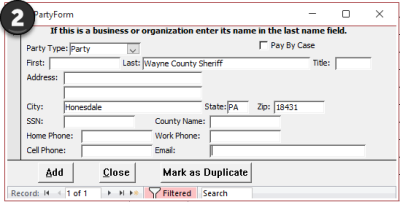Table of Contents
Parties
"Parties" refer to entities that interact with the sheriff's office. Parties can include citizens, businesses, government agencies, or any other entities that have dealings with the sheriff's office for legal processes.
Duplicate Parties
In the Sheriff2k program, users have the ability to add new entities, known as "Parties," via the "PartyForm." Occasionally, users may unintentionally create duplicate parties, resulting in multiple instances of the same entity within the program. This duplication can lead to confusion, especially when multiple records or postings are associated with these duplicate parties.
For instance, if a user mistakenly creates two separate "John Doe" entries and assigns different postings to each of these duplicates, it becomes challenging to reconcile and make sense of these postings in reports. This issue becomes even more problematic when there are more than just two postings linked to these duplicate parties.
We created a [Mark as Duplicate] button on the "PartyForm" to solve this problem.
Remove Duplicate Parties
If a known duplicate party exists, users can follow these steps to resolve the issue:
- Navigate to a case where the affected party is assigned in a dropdown box. Double-click on the party to open the "Party Form."
- A common way to do this is through the "Cases" form. From the "Main Menu," click [Cases].
- Enter a Case # and [Select] a case.
- Click on the [Mark as Duplicate] button.
- A new form called "Duplicate Party Cleanup Form" will appear.
- The "Duplicate Party Cleanup Form" has the following controls:
- "Pick Main Party Record": a dropdown of all parties that are not already duplicates themselves.
- The dropdown includes each party's name, street address, city, and state.
- "Postings Count": the sum of postings tied to both the main party record and the duplicate.
- "[Finish Cleanup]": a button the user can press to finalize their duplicate party cleanup.
- From the "Duplicate Party Cleanup Form," select the main party record for which the duplicate was accidentally created.
Tip: In situations where you encounter multiple entities that share the same name, like attorneys or agencies, and they have multiple addresses, it's essential to use the address field to distinguish which one the duplicate was created for.
For example, let's say you have two parties named "Smith & Associates," and both have similar names but different addresses. One is located at 123 Main Street, while the other is at 456 Elm Avenue. If you come across a duplicate party entry for "Smith & Associates," you should carefully examine the associated addresses before finishing the cleanup.
- Confirm your duplicate cleanup by clicking [Finish Cleanup].
- A message box will appear, displaying the change you're about to make, and will ask if you intend to make this change. Choose [Yes] if all the information appears correct.
Once you've successfully corrected the duplicate party, the program will prevent users from selecting it again from a dropdown box to avoid future duplicate entity usage.

